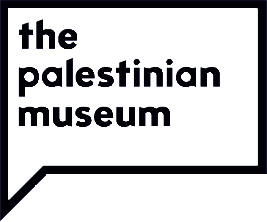From the Palestinian Museum
Digital Archive
“Dear Melia… remember me every time you remember Jordan and its struggles, colonialism and its conspiracies, America and its dollars, Israel and its cunning. Remember me every time you remember Jaffa and its oranges, Haifa and its port, Akka and its mountains, Jerusalem and its holy sites, Gaza and its sacrifices… Remember me, for in reminiscence there is yearning… in yearning there is love… and in love is eternity.”
Between the 1960s and 1970s, Wadad Eskafi sent this letter to her sister Melia from Beit Jala. This letter reached the Palestinian Museum as part of a notebook filled with personal journal entries and letters kept by Melia over the years. Years have passed, and although the letter as a format has changed, nearly disappeared, the content of Melia’s letter feels as though it were written today.
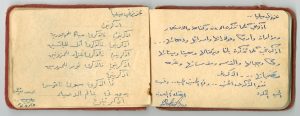
After over a year and a half of work on the Digital Archive, the Palestinian Museum has archived more than 70,000 documents that encompass prominent as well as unseen aspects and landmarks in the history of the Palestinian people. The archive is a free and open source of digital information to all those who are curious to explore Palestinian history and the chronicles of its people. Our own curiosity and research have led us to compile some personal memoirs and correspondences among Palestinians, and to make them available to you.
On November 20, 1956, Layla Tarazi (Jerusalemite educator and militant intellectual) received a letter that was neither from a distant friend nor from an artist Layla had admired, but from the late Egyptian leader Gamal Abdel Nasser himself, thanking her for the noble sentiments expressed in a letter she had previously sent him.
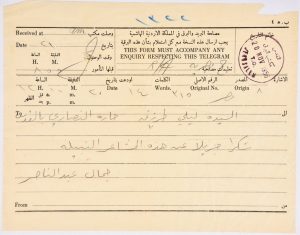
The feelings of amity and affection overwhelmed Mas’ada Daoud as well, who on September 13, 1939, penned a letter to her colleagues, describing plans to celebrate the 50th anniversary of the founding of the Friends Girls School in Ramallah, which she had attended. Mas’ada laments that the prevailing political climate of the time did not allow for a large gathering and proper celebration but insists that there be a small gathering on Saturday, September 23, in the hopes that the situation would soon improve and allow for a fitting celebration.
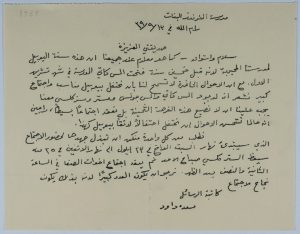
Schools Collection.
Years before the political situation had taken the turn alluded to in Mas’ada’s letter, Aref al-Aref, the Palestinian politician, journalist, and historian, wrote a letter dated June 30, 1920, in the name of the Central Committee of the Arab-Palestinian Society, addressing the Arab Club management. The letter is an invitation for all clubs and associations concerned with Palestinian national issues to attend a general Palestinian conference in Damascus with the aim of outlining a unified position and course of action in opposition to Zionism.
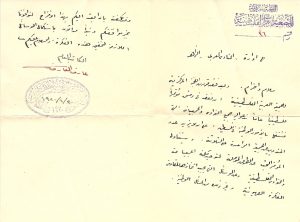
On October 26, 1943, Hussein Ayyad was preoccupied with the bureaucratic process of transporting his share of corn crop from Ramleh to Jerusalem. He reiterates his request in a letter to the Jerusalem governor saying, “I had informed you that I, along with some partners, had a share in a corn yield in Ramleh, and we had petitioned you for permission to transport it to Jerusalem because we have not cultivated anything in the Jerusalem District this year. Your Excellency sent a letter to the governor of Ramleh on September 20,1943, indicating your approval for the transportation of some chickpeas…”
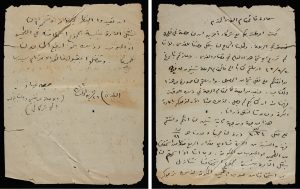
On June 22, 1977, Dr. Amin Khatib (a Jerusalemite militant) wrote an appeal of a different sort, requesting that Sheikh Helmi al-Muhtaseb act “before time runs out and we regret being late in taking the necessary measures to protect the Islamic Holy Sites in the Haram al-Sharif,” suggesting that “all citizens in the West Bank and Gaza participate in guarding the Haram in shifts and in cooperation and coordination with the municipalities, which will provide the necessary funding, select personnel, and ensure their arrival to the Haram al-Sharif.”
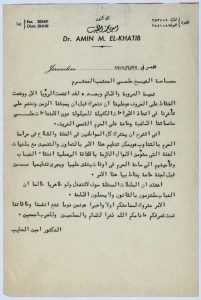
Despite Palestinians’ increasing preoccupation with their political conditions and collective concerns, which are reflected in their correspondences and diaries, the intimate and the personal have always remained present. Perhaps the most common form of such correspondence came in the form of messages written on the back of individual or group photographs.
The beginnings of photography in Palestine date back to the nineteenth century. During and before the 1930s, photos of Palestinians were mostly portraits, especially family portraits. In his book Alternative Snapshots: Early Local Photography in Palestine, 1850–1948, researcher Issam Nassar explains that photography arrived in Palestine in the nineteenth century with European photographers as part of a European and colonial knowledge project. However, its local development was a twentieth-century phenomenon, as photo studios appeared in several Palestinian cities, mainly Jaffa and Jerusalem, then Haifa, Nazareth, Bethlehem, and Ramallah.
On June 24, 1935, a young woman, whose name we could not verify, sent her photo to her friend Jamilah and wrote a poem on its back that reads, “to you Jamilah, I offer this image…as a souvenir of amity…I do not ask for anything in return, for I know that your image is in my heart.”
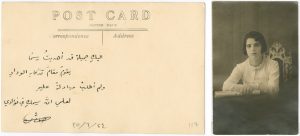
This photo also arrived from Beirut in 1926 with a Christmas greeting on its back.
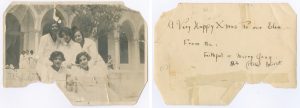
Following the Nakba and the spread of university education, many photos of students appeared in Palestinian albums, either sent home to family members or left as souvenirs. One such example is a message on the back of a photograph that Mohammad Issa Ahmad left his father on August 20, 1962, moments before departing, in which he says, “to my dear father who has cared for me for many years and with whom it is hard to part, with my sincere wishes for a long and happy life and good health.”
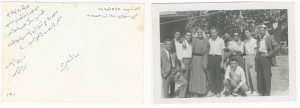
On August 1, 1974, Musa al-Alami (renowned Palestinian politician) received a postcard in Austria from Hala and Dumia Sakakini, the daughters of the educator and intellectual Khalil Sakakini, in which they called him “uncle.” Mailed from Moscow, the card was stamped with Soviet communist imagery as well as a stamp chosen by Hala and Dumia depicting two renowned Russian actors and directors, and founders of the modern theater, Constantin Stanislavski and Vladimir Ivanovich Nemirovich-Danchenko.
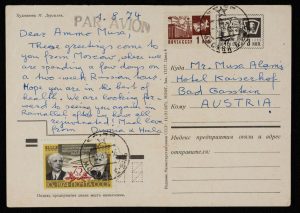
The Palestinian Museum Digital Archive is among the most significant components of the museum’s online platform. The museum is developing an open-access regularly updateable digital archive to document photographs, films, audio, paper documents, books, and other materials, conserving them through digitization from loss, damage, or expropriation.
Do you have any forgotten photographs or documents in a drawer at home? Do you keep valuable archives or collections in your organization? Would you like to see them digitized and made available to researchers and members of the public? Let us provide a treasure trove of knowledge about history and life in Palestine.
Join us and be part of archiving Palestine!
www.palarchive.org

